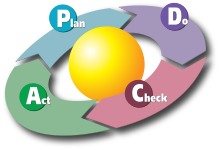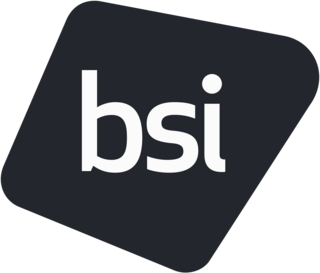ISO 14001 standard
ISO 14001 defines criteria for an EMS. It does not state requirements for environmental performance but maps out a framework that a company or organization can follow to set up an effective EMS. It can be used by any organization that wants to improve resource efficiency, reduce waste, and reduce costs. Using ISO 14001 can provide assurance to company management and employees as well as external stakeholders that environmental impact is being measured and improved. [7] ISO 14001 can also be integrated with other management functions and assists companies in meeting their environmental and economic goals.
ISO 14001, like other ISO 14000 standards, is voluntary, [12] with its main aim to assist companies in continually improving their environmental performance and complying with any applicable legislation. The organization sets its own targets and performance measures, and the standard highlights what an organization needs to do to meet those goals, and to monitor and measure the situation. [12] The standard does not focus on measures and goals of environmental performance, but of the organization. The standard can be applied to a variety of levels in the business, from the organizational level down to the product and service level.
ISO 14001 is known as a generic management system standard, meaning that it is relevant to any organization seeking to improve and manage resources more effectively. This includes:
- single-site to large multi-national companies
- high-risk companies to low-risk service organizations
- the manufacturing, process, and service industries, including local governments
- all industry sectors, including public and private sectors
- original equipment manufacturers and their suppliers
| Year | Edition |
|---|---|
| 1996 | 1st Edition |
| 2004 | 2nd Edition |
| 2015 | 3rd Edition |
ISO 14001:2015
All standards are periodically reviewed by ISO to ensure they still meet market requirements. The current version is ISO 14001:2015, and certified organizations were given a three-year transition period to adapt their environmental management system to the new edition of the standard. The new version of ISO 14001 focuses on the improvement of environmental performance rather than the improvement of the management system itself. [13] It also includes several new updates all aimed at making environmental management more comprehensive and relevant to the supply chain. One of the main updates asks organizations to consider environmental impact during the entire life cycle, although there is no requirement to actually complete a life cycle analysis. Additionally, the commitments of top management and the methods of evaluating compliance have also been strengthened. Another significant change linked ISO 14001 to the general management system structure, introduced in 2015, called the High Level Structure. Both ISO 9001 and 14001 use this same structure, making implementation and auditing more uniform. The new standard also requires the holder of the certificate to specify risks and opportunities and how to address them.
Basic principles and methodology

The basic principles of ISO 14001 are based on the well-known Plan-Do-Check-Act (PDCA) cycle.
Plan: Establish objectives and processes required
Prior to implementing ISO 14001, an initial review or gap analysis of the organization's processes and products is recommended, to assist in identifying all elements of the current operation, and if possible, future operations, that may interact with the environment, termed "environmental aspects". [14] Environmental aspects can include both direct, such as those used during manufacturing, and indirect, such as raw materials. This review assists the organization in establishing their environmental objectives, goals, and targets (which should ideally be measurable); helps with the development of control and management procedures and processes; and serves to highlight any relevant legal requirement, which can then be built into the policy. [14]
Do: Implement the processes
During this stage, the organization identifies the resources required and works out those members of the organization responsible for the EMS' implementation and control. [14] This includes establishing procedures and processes, although only one documented procedure is specifically related to operational control. Other procedures are required to foster better management control over elements such as documentation control, emergency preparedness and response, and the education of employees, to ensure that they can competently implement the necessary processes and record results. Communication and participation across all levels of the organization, especially top management, is a vital part of the implementation phase, with the effectiveness of the EMS being dependent on active involvement from all employees. [14]
Check: Measure and monitor the processes and report results
During the "check" stage, performance is monitored and periodically measured to ensure that the organization's environmental targets and objectives are being met. In addition, internal audits are conducted at planned intervals to ascertain whether the EMS meets the user's expectations and whether the processes and procedures are being adequately maintained and monitored. [14]
Act: Take action to improve performance of EMS based on results
After the checking stage, a management review is conducted to ensure that the objectives of the EMS are being met, the extent to which they are being met, and that communications are being appropriately managed. The set targets are evaluated and if they are not being achieved then they are reevaluated. Additionally, the review evaluates changing circumstances, such as legal requirements, in order to make recommendations for further improvement of the system. These recommendations are incorporated through continual improvement: plans are renewed or new plans are made, and the EMS moves forward. [14]
Continual Improvement Process (CI)
ISO 14001 encourages a company to continually improve its environmental performance. Apart from the obvious – the reduction in actual and possible negative environmental impacts – this is achieved in three ways: [15]
- Expansion: Business areas increasingly get covered by the implemented EMS.
- Enrichment: Activities, products, processes, emissions, resources, etc. increasingly get managed by the implemented EMS.
- Upgrading: The structural and organizational framework of the EMS, as well as an accumulation of knowledge in dealing with business-environmental issues, is improved.
Overall, the CI concept expects the organization to gradually move away from merely operational environmental measures towards a more strategic approach on how to deal with environmental challenges.
Benefits
ISO 14001 was developed primarily to assist companies with a framework for better management control, which can result in reducing their environmental impact. In addition to improvements in performance, organizations can reap a number of economic benefits, including higher conformance with legislative and regulatory requirements [16] by adopting the ISO standard. By minimizing the risk of regulatory and environmental liability fines and improving an organization's efficiency, [17] benefits can include a reduction in waste, consumption of resources, and operating costs. Secondly, as an internationally recognized standard, businesses operating in multiple locations across the globe can leverage their conformance to ISO 14001, eliminating the need for multiple registrations or certifications. [18] Thirdly, there has been a push in the last decade by consumers for companies to adopt better internal controls, making the incorporation of ISO 14001 a smart approach for the long-term viability of businesses. This can provide them with a competitive advantage against companies that do not adopt the standard (Potoki & Prakash, 2005). This in turn can have a positive impact on a company's asset value (Van der Deldt, 1997). It can lead to improved public perceptions of the business, placing them in a better position to operate in the international marketplace. [19] [16] The use of ISO 14001 can demonstrate an innovative and forward-thinking approach to customers and prospective employees. It can increase a business's access to new customers and business partners. In some markets it can potentially reduce public liability insurance costs. It can also serve to reduce trade barriers between registered businesses. [20] There is growing interest in including certification to ISO 14001 in tenders for public-private partnerships for infrastructure renewal. Evidence of value in terms of environmental quality and benefit to the taxpayer has been shown in highway projects in Canada.[ citation needed ]
Conformity assessment
ISO 14001 can be used in whole or in part to help an organization (for-profit or nonprofit) better manage its relationship with the environment. If all the elements of ISO 14001 are incorporated into the management process, the organization may opt to prove that it has achieved full alignment or conformity with the international standard, ISO 14001, by using one of four recognized options. These are: [14]
- make a self-determination and self-declaration, or
- seek confirmation of its conformance by parties having an interest in the organization, such as customers, or
- seek confirmation of its self-declaration by a party external to the organization, or
- seek certification/registration of its EMS by an external organization.
ISO does not control conformity assessment; its mandate is to develop and maintain standards. ISO has a neutral policy on conformity assessment in so much that one option is not better than the next. Each option serves different market needs. The adopting organization decides which option is best for them, in conjunction with their market needs.
Option one is sometimes incorrectly referred to as "self-certify" or "self-certification". This is not an acceptable reference under ISO terms and definitions, as it can lead to confusion in the market. [14] The user is responsible for making their own determination.
Option two is often referred to as a customer or 2nd-party audit, which is an acceptable market term.
Option three is an independent third-party process by an organization that is based on an engagement activity and delivered by specially trained practitioners. This option was based on an accounting procedure branded as the EnviroReady Report, which was created to help small- and medium-sized organizations. Its development was originally based on the Canadian Handbook for Accountants; it is now based on an international accounting standard.
The fourth option, certification, is another independent third-party process, which has been widely implemented by all types of organizations. Certification is also known in some countries as registration. Service providers of certification or registration are accredited by the International Accreditation Forum or national accreditation services such as UKAS in the UK.
ISO 14001 and EMAS
In 2010, the latest EMAS Regulation (EMAS III) entered into force; the scheme is now globally applicable, and includes key performance indicators and a range of further improvements. As of April 2017 [update] , more than 3,900 organizations and approximately 9,200 sites are EMAS registered. [21]
Complementarities and differences
ISO 14001's EMS requirements are similar to those of EMAS. Additional requirements for EMAS include: [2]
- stricter requirements on the measurement and evaluation of environmental performance against objectives and targets
- government supervision of the environmental verifiers
- strong employee involvement; EMAS organizations acknowledge that active employee involvement is a driving force and a prerequisite for continuous and successful environmental improvements.
- environmental core indicators creating multi-annual comparability within and between organizations
- mandatory provision of information to the general public
- registration by a public authority
ISO 14001 use in supply chains
There are many reasons that ISO 14001 should be potentially attractive to supply chain managers, including the use of the voluntary standard to guide the development of integrated systems, its requirement for supply chain members in industries such as automotive and aerospace, the potential of pollution prevention leading to reduced costs of production and higher profits, its alignment with the growing importance of corporate social responsibility, and the possibility that an ISO-registered system may provide firms with a unique environmental resource, capabilities, and benefits that lead to competitive advantage.
Research on the supply chain impact of ISO 14001 registration posited that potential positive impacts might include more proactive environmental management, higher levels of communication, higher levels of waste reduction and cost efficiency, better ROI, higher levels of customer relationship management, fewer issues with employee health, and a reduced number of safety incidents. This research concluded that ISO 14001 registration can be leveraged across the supply chain for competitive advantage. [22]





